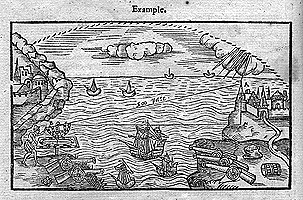 Fig. 63
Fig. 63
 Fig. 63
Fig. 63
Features of the back of the astrolabe could be transferred to dedicated instruments for surveying, leading to the design of a number of instruments where a pivoted alidade moves over a plate engraved with a circular scale of degrees, a geometrical quadrant (shadow square), or both. Such an instrument, like the astrolabe itself, would take angles in a single plane - vertical or horizontal. If the geometrical quadrant dominated the design, the instrument would be so called; if the circular degree scale were more pronounced, a variety of names were used but 'theodolite' became the most common. A theodolite of this sort - a 'simple theodolite' - differed from the modern instrument in having only one divided circle.
Leonard Digges was one of those who proposed a more ambitious configuration and in the book Pantometria, edited and completed by his son Thomas, he arranged the scales of the astrolabe into his 'topographical instrument', for taking vertical and horizontal angles together. The horizontal plate was a divided square with an inscribed circle, while the vertical was a semicircle with an inscribed double shadow square. By this combination altitudes or bearings could be measured as ratios or as degrees (see catalogue no. 43) and the result was a universal instrument, 'seruing most commodiously for all manner mensurations', not least those required for war.
Digges explains how, to get the range of a ship passing a cliff or other vantage point, the gunner should note the reading from the vertical shadow square and, as he puts it, 'then measure the height of the cliffe, or rather the centre of your semicircles altitude aboue the sea'. While he was confident of the usefulness of this technique for range-finding, he pointed out that setting the ordnance for the measured range required a further area of proficiency, but this too was amenable to geometry, or rather to the practical geometer's characteristic combination of mathematical reason and experience.
This conclusion serueth most commodiouslie for all such as shall haue committed to their charge any platforme with ordinaunce, for hereby you may exactly at the first view, tell the distance of any ship or marke, so that hauing a table of Randons made, mounting your peeces accordingly, no vessell can passe by your platforme … but you may with your ordinance at the first bouge hit and neuer bestowe vaine shotte. … But to giue full instruction for shooting great ordinance, and for the variation of Randons … would require a long discourse: I haue thereof in a booke by itself very largely, and I dare be bold to saye, sufficiently entreated: for conferring and conioyning Geometricall demonstration, with my long continued painefull practices, I haue at last reduced that most irregular course & circute of the Bullet (framed and compounded of violent and naturall motions) within the boundes of numbers and Arithmeticall rules, which whether it be difficulte or no, they onely knowe that haue or shall attempt to doe the like. This surely I will say, that as the ignorant in Geometricall and Arithmeticall proportions, shall neuer attaine perfection, though hee turmoile in powder and shot all the dayes of his life: so the Geometer, how excellent so euer he be, leaning onely to discourse of reason, without practise (yea and that sundrie wayes made) shall fall into manifolde errors, or inextricable Laberinthes.
Digges goes on to make it clear that he assigned Tartaglia (see catalogue no. 1) to the latter group; in England in 1571 the geometrical description of the flight of shot was already a matter for discussion and contrary opinion.
The title-page is missing from this copy.